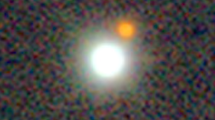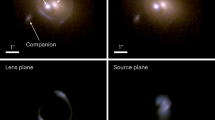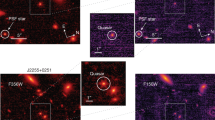Abstract
Exceptionally bright quasars with redshifts up to z = 6.28 have recently been discovered1. Quasars are thought to be powered by the accretion of gas onto supermassive black holes at the centres of galaxies. Their maximum (Eddington) luminosity depends on the mass of the black hole, and the brighter quasars are inferred to have black holes with masses of more than a few billion solar masses. The existence of such massive black holes poses a challenge to models for the formation of structures in the early Universe2,3, as it requires their formation within one billion years of the Big Bang. Here we show that up to one-third of known quasars with z ≈ 6 will have had their observed flux magnified by a factor of ten or more, as a consequence of gravitational lensing by galaxies along the line of sight. The inferred abundance of quasar host galaxies, as well as the luminosity density provided by the quasars, has therefore been substantially overestimated.
This is a preview of subscription content, access via your institution
Access options
Subscribe to this journal
Receive 51 print issues and online access
$199.00 per year
only $3.90 per issue
Buy this article
- Purchase on SpringerLink
- Instant access to full article PDF
Prices may be subject to local taxes which are calculated during checkout


Similar content being viewed by others
References
Fan, X. et al. Survey of z > 5.8 quasars in the Sloan digital sky survey. I. Discovery of three new quasars and the spatial density of luminous quasars at z∼6. Astron. J. 122, 2833–2849 (2001)
Turner, E. L. Quasars and galaxy formation. I—The Z greater than 4 objects. Astron. J. 101, 5–17 (1991)
Haiman, Z. & Loeb, A. What is the highest plausible redshift for quasars? Astrophys. J. 503, 505–517 (2001)
Djorgovski, S. G., Castro, S., Stern, D. & Mahabal, A. A. On the threshold of the reionization epoch. Astrophys. J. 560, L5–L8 (2001)
Press, W. H. & Schechter, P. Formation of galaxies and clusters of galaxies by self-similar gravitational condensation. Astrophys. J. 187, 425–438 (1974)
Barkana, R. & Loeb, A. In the beginning: the first sources of light and the reionization of the universe. Phys. Rep. 349, 125–238 (2001)
Becker, R. H. et al. Evidence for reionization at z∼6: Detection of a Gunn-Peterson trough in a z = 6.28 quasar. Astron. J. 122, 2850–2857 (2001)
Madau, P., Haardt, F. & Rees, M. J. Radiative transfer in a clumpy universe. III. The nature of cosmological ionizing sources. Astrophys. J. 514, 648–659 (1999)
Haiman, Z. & Loeb, A. Observational signatures of the first quasars. Astrophys. J. 503, 505–517 (1998)
Pei, Y. C. The luminosity function of quasars. Astrophys. J. 438, 623–631 (1995)
Fan, X. et al. High redshift quasars found in the Sloan digital sky survey commissioning data. IV. Luminosity function from the fall equatorial sample. Astron J. 121, 54–65 (2001)
Møller, P. & Jakobsen, P. The Lyman continuum opacity at high redshifts: through the Lyman forest and beyond the Lyman valley. Astron. Astrophys. 228, 299–309 (1990)
Ostriker, J. P. & Vietri, M. The statistics of gravitational lensing. III Astrophysical consequences of quasar lensing. Astrophys. J. 300, 68–76 (1986)
Turner, E. L., Ostriker, J. P. & Gott, R. The statistics of gravitational lenses: The distributions of image angular separations and lens redshifts. Astrophys. J. 284, 1–22 (1984)
Turner, E. L. Gravitational lensing limits on the cosmological constant in a flat universe. Astrophys. J. 365, L43–L46 (1990)
Barkana, R. & Loeb, A. High-redshift quasars: Their predicted size and surface brightness distributions and their gravitational lensing probability. Astrophys. J. 531, 613–623 (2000)
Kochanek, C. S. Is there a cosmological constant? Astrophys. J. 466, 638–659 (1996)
Madgwick, D. S. et al. The 2dF galaxy redshift survey: Galaxy luminosity functions per spectral type. Preprint astro-ph/0107197 at 〈http://xxx.lanl.gov〉 (2001).
Blanton, M. R. et al. The luminosity function of galaxies in SDSS commissioning data. Astron. J. 121, 2358–2380 (2001)
Fukugita, M., Shimasaku, K. & Ichikawa, T. Galaxy colours in various photometric band systems. Pub. R. Astron. Soc. Pacif. 107, 945–958 (1995)
Koopmans, L. V. E. & Treu, T. The stellar velocity dispersion of the lens galaxy in MG2016 + 112 at z = 1.004. Astrophys. J. 568, L5–L8 (2002)
Fukugita, M., Hogan, C. J. & Peebles, P. J. E. The cosmic baryon budget. Astrophys. J. 503, 518–530 (1998)
Hogg, D. A meta-analysis of cosmic star-formation history. Preprint astro-ph/105280 at 〈http://xxx.lanl.gov〉 (2001).
Nagamine, K., Cen, R. & Ostriker, J. P. Luminosity density of galaxies and cosmic star-formation rate from Λ cold dark matter hydrodynamical simulations. Astrophys. J. 541, 25–36 (2000)
Djorgovski, S. & Davis, M. Fundamental properties of elliptical galaxies. Astrophys. J. 313, 59–68 (1987)
Wyithe, J. S. B. & Turner, E. L. Cosmological microlensing statistics: Variability rates for quasars and GRB afterglows, and implications for macrolensing magnification bias and flux ratios. Preprint astro-ph/0203214 at 〈http://xxx.lanl.gov〉 (2002).
Schwartz, D. A. A Chandra search for jets in redshift 6 quasars. Preprint astro-ph/0202190 at 〈http://xxx.lanl.gov〉 (2002).
Gunn, J. E. & Peterson, B. A. On the density of neutral hydrogen in intergalactic space. Astrophys. J. 142, 1633–1641 (1965)
Pentericci, L. et.al. VLT optical and near-IR observations of the z = 6.28 quasar SDSS 1030 + 0524. Preprint astro-ph/0112075 at 〈http://xxx.lanl.gov〉 (2001).
Ferrarese, L. Beyond the bulge: a fundamental relation between supermassive black holes and dark matter halos. Pre-print astro-ph/0203469 at 〈http://xxx.lanlgov〉 (2001).
Acknowledgements
We thank E. Turner, J. Winn and R. Barkana for discussions. This work was supported in part by grants from the NSF and NASA. J.S.B.W. is supported by a Hubble Fellowship.
Author information
Authors and Affiliations
Corresponding author
Ethics declarations
Competing interests
The authors declare that they have no competing financial interests.
Rights and permissions
About this article
Cite this article
Wyithe, J., Loeb, A. Magnification of light from many distant quasars by gravitational lenses. Nature 417, 923–925 (2002). https://doi.org/10.1038/nature00794
Received:
Accepted:
Issue Date:
DOI: https://doi.org/10.1038/nature00794



